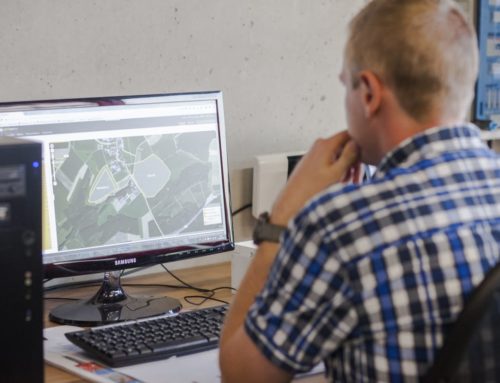Ten Tips for the Optimal Organisation of Your Farm Office
From spring to autumn, most of the work is out in the fields. In the office things are often put to the side and only the most important tasks are completed. Thinking about the growing stacks of paper and unopened bills can cause additional stress. In addition, you often spend a lot of time looking for documents. According to a study, this lack of organisation can cost a company up to € 2,000 a year.
Now the work in the fields is finally done and we are entering a quieter part of the year. Time that you perhaps want to – or have to – use to get some work done in the office. We’ll give you ten helpful tips that you can use now and in the future to help you better organise your farm office and stop desk work from piling up.
1. Set up an office
While this tip might sound obvious, more often than not people work in the corner of their kitchen, with folders and loose papers everywhere, or in a “multifunction room” with boxes stacked up in the corner and lots of “stuff” on the desk – conditions that make it hard to concentrate on work and difficult to store documents in a clear way.
If you have the space available, you should set up a room as a dedicated office. There shouldn’t be anything in the room that isn’t to do with your office work. Here you should be able to concentrate, have some peace and quiet to work and be able to close (or even lock) the door when you need to.
If you do not have a whole room that you can set up as an office, you should clearly separate off an area of a room instead. Cabinets, screens, sliding curtains, etc., are all perfect for separating off an area of a room that you can then use as an office.

2. Tidy up your workspace and make sure that all your devices work
All the tools and devices that you regularly use when working should always be within easy reach. For example, you should place your printer directly next to or behind the desk if possible. You should also always have a notepad and a working pen at hand just in case you want to note something down while you’re on the phone, for example.
Make sure that all your devices are “ready to use”, e.g. check that your printer has enough paper and ink.
It’s also important to make sure that everything has its own place so that you don’t waste time searching everywhere. You can also save time when using your computer by bookmarking important sites. This means that you will be able to log into your 365FarmNet account much faster, for example.
3. Create a farm-specific filing plan
A suitable filing plan is the foundation of an optimal office organisation. The following structure has proven to be very effective:
00 Company management
01 Administration
02 Finance
03 Personnel
04 Funding
05 Crop cultivation
06 Pig farming / fattening
07 Sow management / piglet production
08 Cattle farming and dairy production
09 Poultry fattening
10 Poultry / egg production
11 Projects
It’s a good idea to create a structure that is suitable for your farm and then apply this structure to your computer AND the files in your office. You can work out the structure on your own or ask family members or other employees for their ideas and input.
4. Give all the relevant people an overview and access
If the filing plan was not created jointly, it’s important that you explain the structure of it to all employees so that everyone can directly file or find documents, such as delivery notes for example.
With 365FarmNet, you can involve employees in the operational management of the farm with the Employee Access component. In addition, the 365Crop app makes documentation easy and fast for everyone, even when they’re out and about in the field.
You should also create a substitution plan or emergency instructions in case of an emergency. Even though it’s not a cheerful topic to discuss, it’s important that you compile all the necessary information so that your farm can keep going without you in an emergency. The emergency instructions should name a person that you trust that should be contacted in an emergency – just in case something happens to you or one of your employees. It’s also a good idea to note down the contact persons for the farm at your insurance provider, bank, etc. Who is the authorised doctor? Who knows about a power of attorney?
While having an emergency plan like this is important, it doesn’t replace a proactive, targeted instruction of internal and external trusted persons on the farm’s operational processes and information.
5. Print out the relevant documents and file them away
While many aim to have a paperless office. There are some documents that you do need to keep a paper copy of. For farms, these include notarial contracts, opening balance sheets and annual financial statements.
The “Principles for properly maintaining and storing books, records and documents in electronic form and for data access” (GoBD) explains how you must store other documents according to their obligation to preserve records: Storing documents means that the documents must be in order or findable and must be made available for third parties to read and verify within a reasonable time. In addition, the documents must be stored somewhere where they are safe from fire, flooding and water damage.
It is important to mention that the storage period for a document starts at the end of the calendar year in which the document was created. If you are unsure as to whether a document must be stored in its original form or not, it’s best to check with your accountant or tax adviser.
With 365FarmNet, you can print out and file important documents, like cross-compliance evidence. You can also save this information in digital form as PDF files to reduce paperwork.
6. Sort out and throw away any documents that you don’t need
Now you should get rid of any documents that do not fall under Tip 4 and that you don’t want to keep or that you don’t need to keep for an important reason. You can also scan in any documents that you want to keep and then throw away the “paper version”.
An important step on the road to a paperless office is the digital field catalogue. 365FarmNet makes it easy for you to get started with the free basic package.
7. To-do lists and daily planners are a great way to keep an eye on tasks, deadlines and appointments
The best way to stop office work from piling up is to set aside time to do it and include this time in your calendar. If you set time aside to deal with your documents more frequently, often a 30 to 60 minute session is more than enough. You can even document your activities in the fields directly with the 365Crop app.
It’s also a good idea to add any statutory deadlines, e.g. for submitting applications, to your calendar along with a reminder well before the deadline so that you have plenty of time to get the task done.
8. 60:40 rule – plan some buffer time for any unforeseen
The idea behind the 60:40 rule is that you should only ever plan 60% of your available time. You should leave the other 40% free as a “buffer” for spontaneous representative visits, unforeseen calls, unplanned repairs, etc.
To apply this rule, it’s a good idea to start by working out how much time you need for the recurring activities that you have to do day each day or week. You might be surprised by how much time these activities take up.
9. Eat-That-Frog method – do your least favourite job
The Eat-That-Frog method was thought up by Brian Tracy and is a method that helps people to overcome procrastination. Often, important but unpleasant tasks are put off until they become urgent. They go around and around in your head and can cause lots of stress until they are finally completed. To apply this method, you should create a list of tasks that have been left lying around over the summer or that you have perhaps been wanting to do for a long time.
Now do one task from the list at the start of every day. This means that your thoughts do not revolve around the unpleasant “To do” task for the rest of the day and you can cross something off your list first thing in the morning and (hopefully) feel a little relieved. Do this every day until you’ve crossed everything off your list. With no ifs or buts.
If you want to improve your time management and be more productive, it might be helpful to set some goals for yourself or your farm. Once you’ve identified what you want to achieve in the short, medium or long term, it will be easier for you to carry out the actions needed to meet these goals. To do this you can ask yourself the following questions:
- What do I want to achieve?
- How much do I want to achieve and how can I measure this?
- Why do I want to achieve this goal?
- When do I want to have achieved this goal by?
- How do I want to achieve this goal?
Just make sure to always write down your goals. Once you have noted down your goals you can then add tasks and milestones to them. The author Brian Tracy recommends using the A‑B-C-D‑E method to prioritise your tasks:
- A: Most important and must be completed immediately otherwise there is a risk of negative consequences
- B: Important but can be completed after A tasks, as the consequences of non-completion are less extreme
- C: Can be completed after A and B tasks, the non-completion of C tasks does not have any serious consequences
- D: Needs to be done but should be delegated immediately if possible so that you can focus on the really important things
- E: Is not relevant for the success of the project and should be completed as quickly as possible
10. Decide which tasks you can or want to hand over to someone else to do – either to a tax office or an administrative assistant
If you notice that your office work is making you stressed and that the pile of papers in your office is getting bigger and bigger, then it might be a good idea to delegate this work either internally or externally. For example, you could employ an administrative assistant to support you on a regular basis or you could hand over recurring tasks to a service provider. You should do this for Category D tasks from Tip 9. By doing this, you will ultimately have more time and energy for other tasks and maybe even some extra free time.



